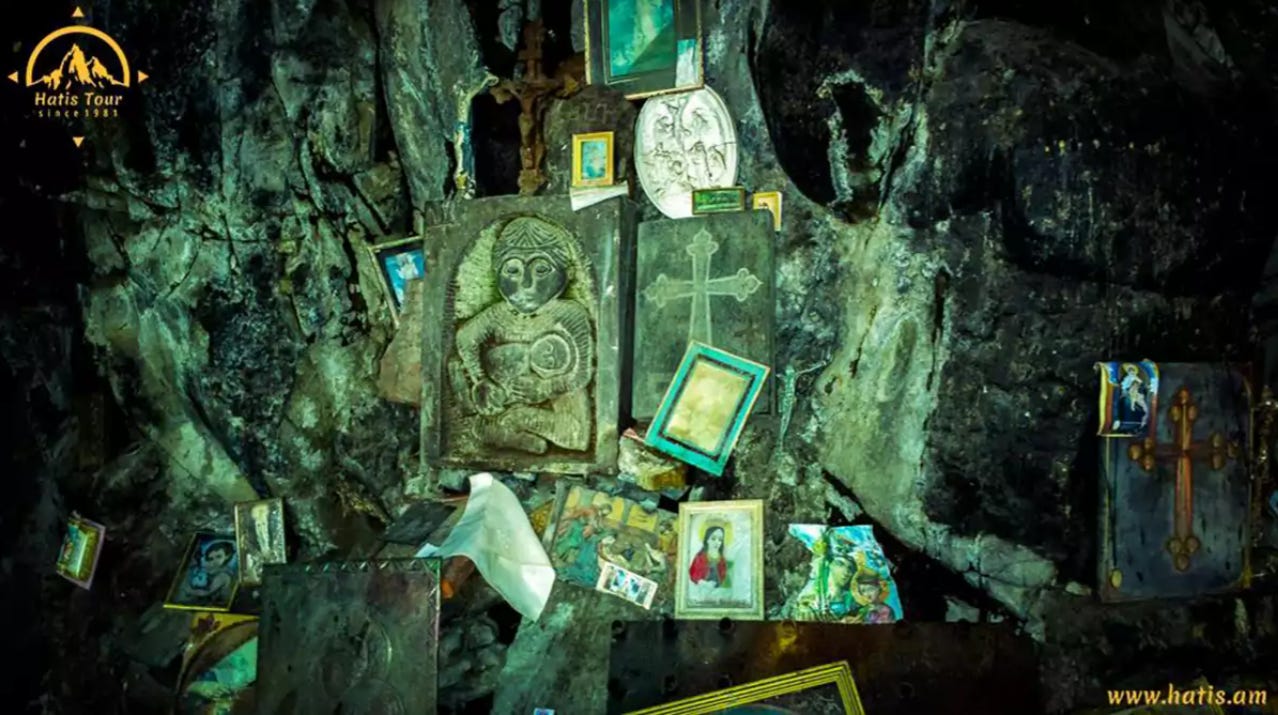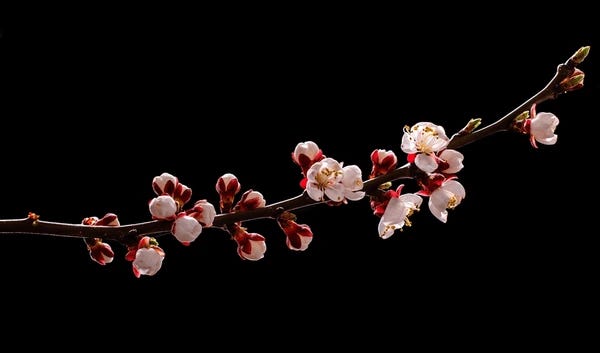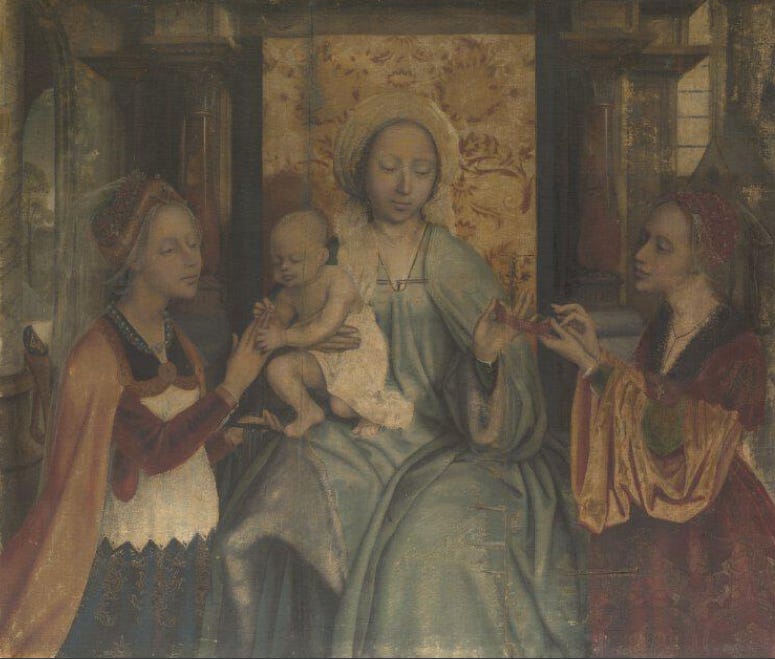We are half way through Commoners’ Advent already, and so it feels like an especial blessing to be offered an opportunity to revisit some of our Advent saints and to meet a new one with the Feast Day of St Barbara on 4th December.
Already, with St Hugh and his Swan Wife we have followed the swan and goose Cygnini saints who cradle the winter in their wings. We have followed the tracks of the wolf saints with St Andrew. And we have met St Martin, the Lantern Bearer, St Catherine, the Lace-maker and Keeper of the Candles, and Old Clem the Blacksmith. Now, fittingly as we move towards the Longest Night, we go underground to follow St Barbara down into the coal-black dark.
St Barbara is said to have been born in the mid-3rd Century in Lebanon (which was then Roman Phoenicia). Despite there being many legends telling us her story, there are no written records of her until the 7th Century, and her veneration, which was wildly popular especially in the East, did not begin until the 9th Century. Indeed, so vague are the details about her life, that she was removed from the Catholic Church’s liturgical calendar of saints in 1969. Not that we need pay any attention to that.
Legend tells us that Barbara was the daughter of a rich Pagan named Dioscorus, who locked her up in a tower in order to guard her from the outside world, and more specifically from the threat of converting to Christianity which at that time was mainly followed by the poor and downtrodden of society and so was held in contempt. However, Barbara had her own thoughts about that and, despite being held in the tower for many years and having her food and laundry provided via a basket on a rope, she did indeed convert, proving her devotion whilst her father was away by having three windows put into a bathhouse that was being built for her as a symbol of the Holy Trinity, rather than the two that he had specified.1
When her father returned from his trip she admitted her newfound faith and was dragged before the prefect of the province, Martinianus, who had her cruelly tortured, before throwing her into prison. Each night of her imprisonment she was healed of her wounds, torches intended to burn her would go out as soon as they came close to her, and the dark prison was bathed in light. Eventually it was decided that Barbara should be beheaded and it was her father who carried out the task, paying for his betrayal when he was struck by lightning and killed on the way home. The site of Barbara’s tomb became a place of miracles, and she is considered to be on of the Fourteen Holy Helpers; a group of saints whose intercession, or prayer, is said to be particularly effective against certain diseases. There are only three female Holy Helpers; Barbara, St Margaret of Antioch, and our Candle Keeper, St Catherine.

In Barbara’s case she is invoked against sudden death, and against lightning and fire. These associations have led to her being called upon in jobs where the danger of explosions is ever present ~ artillerymen, firefighters, firework makers, chemical engineers, geologists, tunnelers, and miners; these last particularly after gunpowder was adopted in mining in 1600.
So interwoven was she with gunpowder that the powder magazine of a ship or fortress was known as a santabárbara (Spanish), a santabarbara (Italian), and a Sainte-Barbe (French). Tradition dictated that a statue of St Barbara must be kept in the magazine to protect from sudden explosions. When a new tunnel was embarked upon in the tunneling industry, it was considered vital to dedicate a small shrine to St Barbara at the tunnel entrance and underground junctions, with a dedication ceremony and prayers made for the protection of those underground.
As if that wasn’t enough, she is also patron saint of Lebanon, mathematicians, prisoners, armourers, and architects!
St Barbara is especially popular in Eastern Europe and in the Middle East. It’s said that her relics are kept in St Michael’s Golden-Domed Monastery in Kyiv, Ukraine. In Georgia, her day is celebrated as ‘Barbaroba’ on December 17th (going by the older Julian calendar), during which the traditional Georgian bean bread, lobiani, is eaten.
In Greece and Cyprus, her Feast Day is celebrated amongst the artillery corps and a traditional sweet doughnut called loukoumades is consumed. In 13th Century Arabic cookbooks the honey-soaked desert is named as luqmat al-qādi (لُقْمَةُ ٱلْقَاضِيِ), or "judge's morsels". It is even mentioned in the collection of Arabic folktales, ‘One Thousand and One Nights’, which dates back to at least the Middle Ages. In Turkey the dish, known there as lokma, is cooked by close friends and relatives of a deceased person forty days after their death and given to neighbours and passersby in exchange for a prayer for the soul of the dead.
In Armenia, St Barbara, known there as Kuys Vavara, is revered in a cave shrine on Mount Ara, known as the ‘Flower Monastery’ where candles and flower garlands are placed in her honour. The mossy cave is said to contain a sacred spring.
St Barbara is celebrated by Middle Eastern Christians in Lebanon, Syria, Jordan, Palestine, and Turkey on her Feast Day of Eid il-Burbara, either on the 4th or 17th December, depending which calendar is followed. In the Middle East, her celebration has much in common with our old traditions of trick or treating, clementing, catterning, and caroling; adults and children will visit each house in their village in disguise and perform dances and songs telling the story of St Barbara in exchange for food. This echoes the belief of Levantine Christians that the saint employed many disguises when she fled persecution by the Romans. In Lebanon, wheat seeds are planted in cotton wool on Eid il-Burbara to commemorate the story that, during her flight, she ran through a newly planted wheat field, which immediately grew tall to cover her tracks. These seeds will grow up to 6 inches by Christmas Day and are then used to decorate Nativity scenes.
Traditional foods eaten on Eid il-Burbara are the Palestinian, ‘burbura’; a dish of wheat grains, pomegranate seeds, raisins, anise, and sugar, originally from the Christian village of Aboud in the West Bank, which again is offered to children who are going from house to house, and Qatayef, a sweet dumpling filled with walnuts or cheese. A similar dish to burbura, kutya, is served in Poland as part of the traditional Christmas Eve supper.
As an aside, the barbiturate family of drugs, used for their anti-anxiety and sedative effects, are also named after our ubiquitous saint. The story is that, on St Barbara’s Feast Day in 1864, the chemist Adolf von Baeyer met an artilleryman in a local tavern whilst celebrating his discovery of the parent compound. The artilleryman, who was there raising a glass to his patron saint, suggested her name for the new discovery and von Baeyer agreed.
Getting back to treats, others have also been inspired to create delicious food in honour of St Barbara. You can find Gather Victoria’s St Barbara’s Christmas Cake (a German lemon loaf cake) here, together with a fascinating exploration of threads linking St Barbara to pre-Christian goddesses. She writes of a tradition in Germany that;
“Barbara watered a branch from a cherry tree during her time in the tower. After her death, the cherry branch she’d kept blossomed. From this comes “Barbarazweig,” the custom of unmarried women bringing branches (preferably Cherry) into the house on December 4th. If they bloomed on 25 December, it was a sign of good luck – and meant you would be married in the new year. This Christmas custom likely has roots in pre-Christian times when blossoming twigs and branches symbolized the Goddess who creates new life in the depths of winter.”2
You can read another recipe for St Barbara’s Cake, together with more about St Barbara’s Twigs on ‘Kitchen Lioness:Notes from a Very Small German Kitchen’ here.

For the Barbarazweige, the cherry branches should be cut on a mild day (which should of course be St Barbara’s Feast Day), the ends of the branches crushed and then submerged in cool water for several hours. They should then be placed in a vase somewhere cool for a few days until the buds begin to swell. The vase can then be brought into the warm with the hope that cherry blossom will appear on Christmas Day.
That Barbara was a hugely popular saint in Germany is shown by the many traditions relating to her there. In some areas a Barbara tree (Barbarabaum), created from larger branches of fruit trees, is brought into the house and decorated much like a Christmas tree. In others, Barbarastag was seen as the beginning of the festive gift-giving season and children would leave shoes by their doors overnight for St Barbara to put presents in (now more often associated with St Nicholas’ Feast Day on December 5th). But my favourite of the German traditions comes from Saxony, Thuringia, Silesia, and Bohemia, where 'St Barbara’s Lights’ are lit underground by miners on her Feast Day with prayers for their protection through the year ahead.3
The image below is of the shrine to St Barbara in the Altaussee salt mine in Austria. The saltzwelten.at blog tells us that, every 4th December;
“The chapel 700 meters below ground is full of fragrances – saturated with the smells of fir needles, incense and candle wax. The lighting – pallid and subdued. Illuminated in the glow of white candles, an impressive altar of pure orangey-red rock salt stands in the middle of the chapel. To the right and left of this are two big Christmas trees, decorated with strands of lights and stars made from straw. Solemnly, a wind ensemble opens the festivities and the priest, assisted by his acolytes, commemorates the martyr Barbara and pleads for her protection.”
There are also small statues to St Barbara in many of the mine’s side tunnels, which are decorated with pine branches and candles for her Feast Day; Barbarafeier.
It is almost time to end by gathering together the threads that weave from St Barbara into our Commoners’ Advent journey, but first I really must share just one more enchantment; that St Barbara may have been the inspiration for the German fairytale of Rapunzel!

First recorded by the Brothers Grimm in 1812, Rapunzel is one of many ‘Maiden in the Tower’ myths. It has been proposed by researchers that they find their roots in pre-Christian sun goddess mythology, in which the sun is trapped and then rescued. One such myth is that of the Baltic solar deity, Saulė who, like St Barbara, is kept hostage in a tower by a powerful king until rescued by the hero, Zodiac (the astronomical constellations).
And so here in St Barbara we have a symbol of the sun in the , invoked against fire and lightning, causing fruit trees to flower in the winter, and protecting those whose work takes them underground. Saint of the tunnel and the cave, the blossom and the burrow, and, as ally to the miners, bringer of the coal that fuels the midwinter forge of Old Clem.
Her name comes from the Greek word ‘bárbaros’, meaning both ‘stranger’ and ‘babbler’; someone who spoke in a language that couldn’t be understood.4 The Early Christians would sometimes call themselves ‘barbarians’ to differentiate themselves from the occupying powers of their lands. She is with the people of Palestine and Lebanon as they stand against Occupation. She is with the badger hiding from the cull. She was with the miners on the picket lines. She is the sun of human and other-than-human dignity waiting to be reborn from the darkness of Empire and Capitalism. She is the spark in the dark.
As we continue our journey through Commoners’ Advent may we too root ourselves in an older tongue; one that means nothing to those who would steal the Commons, but understood by the burrowers and the diggers; the badger, the mole, the earthworm, and the bumblebee in her winter nest, the sleeping seeds and the mycelial threads. And may we cling to the hope that there is a light that will never go out. The blossom that dares to flower in the midwinter dark tells us so.
#CommonersAdvent #OldAdvent #CelticAdvent #StMartinsLent #WinterLent
I am determined to continue offering my work free of charge, because that too is resistance, but if you would ever like to support me with pennies you can do that at https://ko-fi.com/radicalhoneybee. Thank you so much, both for pennies and for all other forms of support, all of which are worth more than their weight in gold.
References:
St Barbara, Wiki
St Barbara Fleeing from Her Father, painting in Dulwich Picture Gallery by Peter Paul Rubens
St Barbara Kneeling by Nesterov, Sotherby’s, 1924
Eid il-Burbara, Wiki
The Legend of St Barbara: Patron Saint of Mines, PDF
More on the Altaussee salt mine
Barbara (meaning of the given name)

Barbara’s Twigs ~ video in German
















Ah, this is wonderful! And also: Mining For Gold! I love the Cowboy Junkies rendition of that song.
I'm loving this Advent series so much. Thank you 🙏🏻